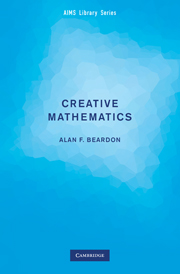16 - Problem A: Discussion and Generalisations
Published online by Cambridge University Press: 16 May 2024
Summary
From now on, we shall only consider cases in which each circle lies outside the other circles.We begin by examining the problem when the triangle has been replaced by a quadrilateral. First, we must define the problem: we take any quadrilateral and ask whether we can find four circles, with their centres located at the vertices, such that each circle is tangent to each of the two adjacent circles. Let the lengths of the sides of the quadrilateral be L1,L2,L3,L4. Then the circles exist if and only if there is a positive solution to the equations
If we write these equations in matrix form with M the matrix of coefficients, then we find that M has determinant zero (check this). Then linear algebra tells us that either (i) there is no solution, or (ii) there are infinitely many (but not necessarily positive) solutions. If we consider a square, and also a long thin rectangle, we can easily see that each of (i) and (ii) can arise. It is clear from (1) that L1 + L3 = L2 + L4 is a necessary condition for a solution to exist. Could this also be a sufficient condition for a solution to exist? We prove that it is.
Theorem A solution exists for a quadrilateral with sides of lengths L1, L2, L3 and L4 if and only if L1 + L3 = L2 + L4. Moreover, if this is so, then there are infinitely many solutions to the problem
Proof We suppose that L1 + L3 = L2 + L4, and we may assume (by relabelling) that L4 is the longest side. Now choose any r1 and put r2 = L3 − r1, r3 = L4 − L3 + r1 and r4 = L2 − r1. It is easy to check that these rj satisfy the equations (1), and that, providing that r1 is sufficiently small and positive, each rj is positive.
If we use the same method as above in the case of an n–gon, and label the sides L1,L2, … appropriately, then we obtain the system of equations
- Type
- Chapter
- Information
- Creative MathematicsA Gateway to Research, pp. 71 - 74Publisher: Cambridge University PressPrint publication year: 2009

